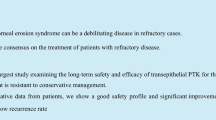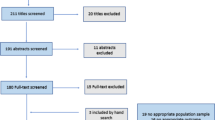Abstract
Purpose
To describe the demographic characteristics and clinical course of Fuchs endothelial corneal dystrophy (FECD) in a Mexican-mestizo population.
Methods
A retrospective observational and longitudinal study was performed in consecutive patients with the clinical diagnosis of Fuchs endothelial corneal dystrophy seen at our institution. Initial and last follow-up best-corrected visual acuity, slit-lamp findings, and specular microscopy endothelial morphometric parameters were analyzed.
Results
One hundred and two eyes belonging to 51 patients were included in the analysis. Median age at the time of diagnosis was 69 years (range, 25–87 years) with a female-to-male ratio of 3.3:1. Visual loss (40%) followed by glare (13.3%) and fluctuating matutine vision loss (13.3%) was the most common complaints at presentation. Regarding FECD staging, 65 (63.7%) were classified as stage-I FECD, 21 (20.6%) stage-II, and 15 (14.7%) as stage-III. A high percentage of eyes (44.1%) presented visual impairment ( ≤ 20/50) at presentation, and the presence of isolated corneal guttata was the most common stage of presentation (64%) at slit-lamp examination. While fifty-nine (57.8%) eyes did not require any medical or surgical management, 17 (16.7%) eyes were managed with hypertonic saline eyedrops alone or in combination with bandage contact lens, and 18 (17.6%) required corneal transplantation. Penetrating keratoplasty alone (8 eyes, 44.4%), or in combination with cataract extraction and intraocular lens implantation (3 eyes, 16.7%), was the most frequent surgical technique performed.
Conclusion
Demographical characteristics of Fuchs dystrophy regarding age at presentation, gender distribution, and clinical stage at the time of diagnosis did not differ significantly from other international reports. Almost 20% of these patients will require keratoplasty during the disease, emphasizing the need for safer and more reproducible keratoplasty techniques.

Adapted from: Adamis AP, Filatov V, Tripathi BJ, Tripathi RC (1993) Fuchs' endothelial dystrophy of the cornea. Surv Ophthalmol 38:149–68. https://doi.org/10.1016/0039-6257(93)90099-s



Similar content being viewed by others
References
Gain P, Jullienne R, He Z, Aldossary M, Acquart S, Cognasse F, Thuret G (2016) Global survey of corneal transplantation and eye banking. JAMA Ophthalmol 134:167–173. https://doi.org/10.1001/jamaophthalmol.2015.4776
Elhalis H, Azizi B, Jurkunas UV (2010) Fuchs endothelial corneal dystrophy. Ocul Surf 8:173–184. https://doi.org/10.1016/s1542-0124(12)70232-x
Sarnicola C, Farooq AV, Colby K (2019) Fuchs endothelial corneal dystrophy: update on pathogenesis and future directions. Eye Contact Lens 45:1–10. https://doi.org/10.1097/ICL.0000000000000469
Afshari NA, Pittard AB, Siddiqui A, Klintworth GK (2006) Clinical study of Fuchs corneal endothelial dystrophy leading to penetrating keratoplasty: a 30-year experience. Arch Ophthalmol 124:777–780. https://doi.org/10.1001/archopht.124.6.777
Adamis AP, Filatov V, Tripathi BJ, Tripathi RC (1993) Fuchs’ endothelial dystrophy of the cornea. Surv Ophthalmol 38:149–168. https://doi.org/10.1016/0039-6257(93)90099-s
Moshirfar M, Somani AN, Vaidyanathan U, Patel BC (2021) Fuchs Endothelial Dystrophy. StatPearls, Treasure Island (FL)
Goar EL (1933) Dystrophy of the corneal endothelium (cornea guttata), with report of a histologic examination. Trans Am Ophthalmol Soc 31:48–59
Lorenzetti DW, Uotila MH, Parikh N, Kaufman HE (1967) Central cornea guttata. Incidence in the general population. Am J Ophthalmol 64:1155–1158
Eghrari AO, McGlumphy EJ, Iliff BW, Wang J, Emmert D, Riazuddin SA, Katsanis N, Gottsch JD (2012) Prevalence and severity of fuchs corneal dystrophy in Tangier Island. Am J Ophthalmol 153:1067–1072. https://doi.org/10.1016/j.ajo.2011.11.033
Zoega GM, Fujisawa A, Sasaki H, Kubota A, Sasaki K, Kitagawa K, Jonasson F (2006) Prevalence and risk factors for cornea guttata in the Reykjavik eye study. Ophthalmology 113:565–569. https://doi.org/10.1016/j.ophtha.2005.12.014
Kitagawa K, Kojima M, Sasaki H, Shui YB, Chew SJ, Cheng HM, Ono M, Morikawa Y, Sasaki K (2002) Prevalence of primary cornea guttata and morphology of corneal endothelium in aging Japanese and Singaporean subjects. Ophthalmic Res 34:135–138. https://doi.org/10.1159/000063656
Nagaki Y, Hayasaka S, Kitagawa K, Yamamoto S (1996) Primary cornea guttata in Japanese patients with cataract: specular microscopic observations. Jpn J Ophthalmol 40:520–525
Higa A, Sakai H, Sawaguchi S, Iwase A, Tomidokoro A, Amano S, Araie M (2011) Prevalence of and risk factors for cornea guttata in a population-based study in a southwestern island of Japan: the Kumejima study. Arch Ophthalmol 129:332–336. https://doi.org/10.1001/archophthalmol.2010.372
Repp DJ, Hodge DO, Baratz KH, McLaren JW, Patel SV (2013) Fuchs’ endothelial corneal dystrophy: subjective grading versus objective grading based on the central-to-peripheral thickness ratio. Ophthalmology 120:687–694. https://doi.org/10.1016/j.ophtha.2012.09.022
Sun SY, Wacker K, Baratz KH, Patel SV (2019) Determining subclinical edema in Fuchs endothelial corneal dystrophy: revised classification using scheimpflug tomography for preoperative assessment. Ophthalmology 126:195–204. https://doi.org/10.1016/j.ophtha.2018.07.005
Chylack LT Jr, Wolfe JK, Singer DM, Leske MC, Bullimore MA, Bailey IL, Friend J, McCarthy D, Wu SY (1993) The lens opacities classification system iii. the longitudinal study of cataract study group. Arch Ophthalmol 111:831–836. https://doi.org/10.1001/archopht.1993.01090060119035
Jabs DA, Nussenblatt RB, Rosenbaum JT (2005) Standardization of uveitis nomenclature for reporting clinical data. results of the first international workshop. Am J Ophthalmol 140:509–516. https://doi.org/10.1016/j.ajo.2005.03.057
Rosenblum P, Stark WJ, Maumenee IH, Hirst LW, Maumenee AE (1980) Hereditary fuchs’ dystrophy. Am J Ophthalmol 90:455–462. https://doi.org/10.1016/s0002-9394(14)75011-1
Chan SWS, Yucel Y, Gupta N (2018) New trends in corneal transplants at the University of Toronto. Can J Ophthalmol 53:580–587. https://doi.org/10.1016/j.jcjo.2018.02.023
Zhang X, Igo RP, Jr., Fondran J, Mootha VV, Oliva M, Hammersmith K, Sugar A, Lass JH, Iyengar SK, Fuchs’ Genetics Multi-Center Study G (2013) Association of smoking and other risk factors with Fuchs’ endothelial corneal dystrophy severity and corneal thickness. Invest Ophthalmol Vis Sci 54:5829–5835. https://doi.org/10.1167/iovs.13-11918
Liu C, Miyajima T, Melangath G, Miyai T, Vasanth S, Deshpande N, Kumar V, Ong Tone S, Gupta R, Zhu S, Vojnovic D, Chen Y, Rogan EG, Mondal B, Zahid M, Jurkunas UV (2020) Ultraviolet a light induces DNA damage and estrogen-DNA adducts in Fuchs endothelial corneal dystrophy causing females to be more affected. Proc Natl Acad Sci U S A 117:573–583. https://doi.org/10.1073/pnas.1912546116
Zinflou C, Rochette PJ (2017) Ultraviolet A-induced oxidation in cornea: characterization of the early oxidation-related events. Free Radic Biol Med 108:118–128. https://doi.org/10.1016/j.freeradbiomed.2017.03.022
Godar DE, Wengraitis SP, Shreffler J, Sliney DH (2001) UV doses of Americans. Photochem Photobiol 73:621–629. https://doi.org/10.1562/0031-8655(2001)073%3c0621:udoa%3e2.0.co;2
Castanedo-Cazares JP, Lepe V, Gordillo-Moscoso A, Moncada B (2003) Ultraviolet radiation doses in Mexican students. Salud Publica Mex 45:439–444
Castanedo-Cazares JP, Torres-Alvarez B, Medellin-Perez ME, Aguilar-Hernandez GA, Moncada B (2006) Knowledge and attitudes of Mexican population concerning solar radiation. Gac Med Mex 142:451–455
Zhang J, McGhee CNJ, Patel DV (2019) The molecular basis of fuchs’ endothelial corneal dystrophy. Mol Diagn Ther 23:97–112. https://doi.org/10.1007/s40291-018-0379-z
Gottsch JD, Sundin OH, Liu SH, Jun AS, Broman KW, Stark WJ, Vito EC, Narang AK, Thompson JM, Magovern M (2005) Inheritance of a novel COL8A2 mutation defines a distinct early-onset subtype of fuchs corneal dystrophy. Invest Ophthalmol Vis Sci 46:1934–1939. https://doi.org/10.1167/iovs.04-0937
Kobashi H, Kamiya K, Shimizu K (2018) Factors influencing visual acuity in fuchs’ endothelial corneal dystrophy. Optom Vis Sci 95:21–26. https://doi.org/10.1097/OPX.0000000000001157
McGlumphy EJ, Margo JA, Haidara M, Brown CH, Hoover CK, Munir WM (2018) Predictive value of corneal donor demographics on endothelial cell density. Cornea 37:1159–1162. https://doi.org/10.1097/ICO.0000000000001664
Ewete T, Ani EU, Alabi AS (2016) Normal corneal endothelial cell density in Nigerians. Clin Ophthalmol 10:497–501. https://doi.org/10.2147/OPTH.S97070
Kwon JW, Cho KJ, Kim HK, Lee JK, Gore PK, McCartney MD, Chuck RS (2016) Analyses of factors affecting endothelial cell density in an eye bank corneal donor database. Cornea 35:1206–1210. https://doi.org/10.1097/ICO.0000000000000921
Duman R, Tok Cevik M, Gorkem Cevik S, Duman R, Perente I (2016) Corneal endothelial cell density in healthy Caucasian population. Saudi J Ophthalmol 30:236–239. https://doi.org/10.1016/j.sjopt.2016.10.003
Seitzman GD, Gottsch JD, Stark WJ (2005) Cataract surgery in patients with Fuchs’ corneal dystrophy: expanding recommendations for cataract surgery without simultaneous keratoplasty. Ophthalmology 112:441–446. https://doi.org/10.1016/j.ophtha.2004.10.044
Kopplin LJ, Przepyszny K, Schmotzer B, Rudo K, Babineau DC, Patel SV, Verdier DD, Jurkunas U, Iyengar SK, Lass JH, Fuchs’ Endothelial Corneal Dystrophy Genetics Multi-Center Study G (2012) Relationship of Fuchs endothelial corneal dystrophy severity to central corneal thickness. Arch Ophthalmol 130:433–439. https://doi.org/10.1001/archopthalmol.2011.1626
Prasad A, Fry K, Hersh PS (2011) Relationship of age and refraction to central corneal thickness. Cornea 30:553–555. https://doi.org/10.1097/ICO.0b013e3181fb880c
Patel SV, Hodge DO, Treichel EJ, Spiegel MR, Baratz KH (2020) Predicting the prognosis of fuchs endothelial corneal dystrophy by using scheimpflug tomography. Ophthalmology 127:315–323. https://doi.org/10.1016/j.ophtha.2019.09.033
Castellucci M, Novara C, Casuccio A, Cillino G, Giordano C, Failla V, Bonfiglio V, Vadala M, Cillino S (2021) Bilateral ultrathin descemet’s stripping automated endothelial keratoplasty vs. bilateral penetrating keratoplasty in Fuchs’ dystrophy: corneal higher-order aberrations, contrast sensitivity and quality of life. Medicina 57(2):133. https://doi.org/10.3390/medicina57020133
Price MO, Gorovoy M, Price FW Jr, Benetz BA, Menegay HJ, Lass JH (2013) Descemet’s stripping automated endothelial keratoplasty: three-year graft and endothelial cell survival compared with penetrating keratoplasty. Ophthalmology 120:246–251. https://doi.org/10.1016/j.ophtha.2012.08.007
Acknowledgements
The authors want to thank Susana Imperial Sauceda for her technical support in performing all specular microscopy studies.
Funding
Partially supported by The Immuneye Foundation, Monterrey, Mexico.
Author information
Authors and Affiliations
Contributions
MBS contributed to study protocol preparation, Ethics and Research Committees submission and revision, patients´ assignment, data collection and analysis, manuscript writing and editing; JCHC contributed to study design, statistical analysis, manuscript writing, and revision; RERL contributed to data collection, manuscript writing and revision, tables, and figures editing; ARG contributed to original idea, project coordination, study design, funds raising, manuscript writing and editing. All authors read and approved the final manuscript.
Corresponding author
Ethics declarations
Conflict of interest
The authors declare no conflicts of interest nor financial disclosures.
Data availability
Data of this study are available upon request from the corresponding author. The data are not publicly available because the study was approved under informed consent for research purposes, protecting the participants´ privacy, prohibiting sharing information with third parties according to the Mexican General Law for the Protection of Personal Data in Possession of Obliged Parties.
Ethical approval
The study was conducted according to the guidelines of the Declaration of Helsinki and approved by the Ethics (Registration No. P000355-CCEDEFM-CEIC-CR002) and Research (Registration No. P000355-CCEDEFM-CI-CR002) Committees of our institution (License No. CONBIOETICA 19 CEI 011–2016-10–17 and COFEPRIS 20 CI 19 039 002, respectively).
Informed consent statement
Informed consent by the patient was obtained to disclose health information and publish clinical images.
Additional information
Publisher's Note
Springer Nature remains neutral with regard to jurisdictional claims in published maps and institutional affiliations.
Rights and permissions
About this article
Cite this article
Barrera-Sanchez, M., Hernandez-Camarena, J.C., Ruiz-Lozano, R.E. et al. Demographic profile and clinical course of Fuchs endothelial corneal dystrophy in Mexican patients. Int Ophthalmol 42, 1299–1309 (2022). https://doi.org/10.1007/s10792-021-02117-0
Received:
Accepted:
Published:
Issue Date:
DOI: https://doi.org/10.1007/s10792-021-02117-0




